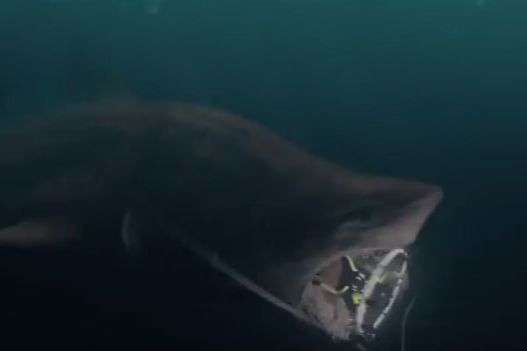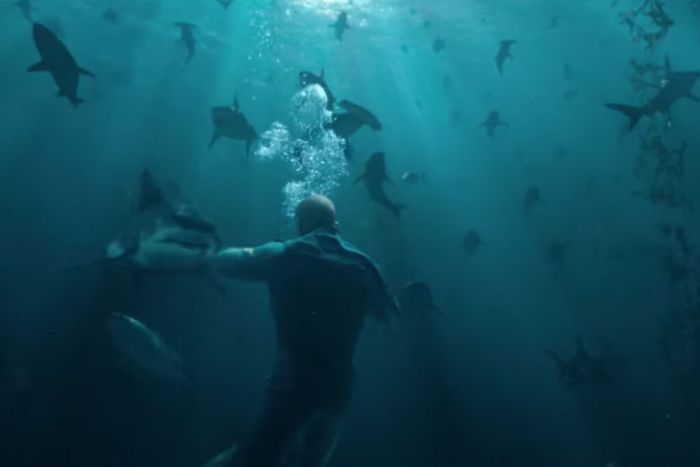
The Meg may have surprised us all with its weekend box-office haul (with an estimated $44.5 million, it’s Warner Bros.’ top opening of 2018, besting Ready Player One and Ocean’s 8). But nobody will be shocked to learn that the movie — a dream matchup between Jason Statham and a megalodon, the largest shark that ever lived — takes certain liberties when it comes to science.
To fact-check the feasibility of the film’s plot and portrayal of megalodons, we spoke with two Meg experts who helped the Discovery Channel critique its own infamous 2013 “documentary” Megalodon: The Monster Shark Lives: Dana Ehret, assistant curator of natural history at the New Jersey State Museum, who did his Ph.D. work on megalodon and fossil great white sharks; and Lisa Whitenack, a biology professor at Allegheny College, whose research includes the biomechanics, evolution, and paleobiology of sharks (and who dressed as Sharknado last year for Halloween).
The movie says: Megalodons were 70 to 90 feet long.
The experts say: The size is exaggerated. Based on what we know about the ratio of tooth size to body length in modern great whites, the megalodon is estimated to have been around 60 feet long, according to Whitenack. Ehret posits a range of 50 to 55 feet: “There are some extremely large megalodon teeth, a few that would show that they might have been bigger than that, but certainly not 90 feet,” he says. “Definitely not.”
Whitenack does applaud the visual effects team for the shark’s dorsal fin, which has a ragged edge: “They got reality points for that over the megalodon documentary on Discovery Channel.” But she noticed the effects team gave the Meg eight gill slits when it should have had five. “Every living shark, except for a handful of species, have five gill slits. So sixgills have six, sevengills have seven, and everyone else has five, including all the sharks in the same order that megalodon was in,” she says. “They made them flutter very prettily — that’s actually what made me notice, ‘What’s going on with this? Oh, God! No!’ That bothered me the whole time.”
Also distracting to her: If we see the shark’s dorsal fin and back as it chases humans at the surface of the water, we should also be able to view the tip of its caudal fin (read: tail). “Unless it was swimming at a tilt, with just its head and part of its back up, which doesn’t really work for speed,” she says. (Also: she’d like to know why Statham’s heroic Jonas Taylor didn’t don flippers when he swam out to put a tracking tag on the first Meg: “I leaned over to my husband and I was like, ‘Where are his fins?’ Like, just get in there barefoot?”)
The movie says: Megalodons had jaws strong enough to bite a whale in half, and could potentially swallow an unbreakable polycarbonate dive cage whole (with a person, Li Bingbing’s marine biologist Suyin, inside it).
The experts say: They’re skeptical about the Meg biting a whale in half, even with the Meg’s bite force estimated to be between 24,000 to 40,000 pounds per square inch. “A very, very small whale, like a dolphin or something like that, sure. If they hit in the exact right spot, right between two vertebrae, then they might be able to, but that’s like a one in a million shot,” Whitenack says. “[But] there’s no doubt that they ate whales. There are all sorts of whale fossils that have bite marks that had to be from something large, like a megalodon. So we know that they were strong, and just based on their size, they’re gonna have a pretty hefty bite — definitely bigger than anything we have now force-wise.”
As for whether Meg could have cleanly devoured that cage? Ehret says a real megalodon’s jaws would’ve been six feet across, capable of swallowing a person without taking a bite. So if you ramp up the length of the shark and its jaw size, it’s conceivable. Whitenack, however, saw another problem with that scenario: “Think about humans: we can’t swallow very well with our mouths open, right? Try it. When you go to the dentist and they’re working in there, that’s why they have the sucky thing. For the Meg, there’s nothing in there that can move the cage back for swallowing it whole with its mouth so open like that,” she says. “There are sharks that can spit stuff out and suck it back in, but white sharks or megalodons really can’t do that. It would have had to close its mouth completely with the cage inside to swallow that.”
The movie says: Megalodons can breach — not just to attack swimmers on floating docks, but completely out of the water to eat a smaller Meg on the deck of a boat.
The experts say: First of all, Jonas & Co. would have needed a bigger boat. That small research vessel wouldn’t have had a winch strong enough to raise any Meg aboard — or be floating soundly afterward. Some estimates of megalodon’s weight rival that of the blue whale, at 100 tons. “It probably would have brought the boat down with it,” Ehret says.
Both he and Whitenack agree that were Megs to breach — blue whales do, after all — it wouldn’t be completely out of the water, like today’s great whites. Whitenack understands why director Jon Turteltaub would include spectacular breaches — “Who doesn’t love an airborne shark?” — but she had a particular problem with it jumping to attack that smaller Meg: “How the heck did the bigger Meg know that the other Meg was even there on the back of the boat? Yeah, it’s probably dripping blood and gore into the water, but why would the shark think, ‘Hey, I’m gonna leap out and get that thing’? Could it see up there? I’m guessing not,” she says. “The only time I’ve seen a shark track a person above the water is if they’re up at the surface, or they see you through like a plastic thing or something like that. So I’m very skeptical of the whole premise of going, ‘Hey, there’s food up on that boat. Let me go get it.’”
For the record, Ehret also doubts that a large female Meg, which would have considerable girth, would come close enough to shore at China’s Sanya Bay to encounter swimmers. “It would have been a fairly thick animal and probably would have just run aground if it came in that close,” he says.
The movie says: A Meg would stare at a little 8-year-old girl (scene-stealer Sophia Shuya Cai) playing in the long glass hallway of an underwater research facility.
The experts say: They’re not buying it. “Based on where the eyes are, I’m not sure that the shark actually would have been able to see the little girl while it was hovering there,” Whitenack says. “The eyes are on the side of the head, and I’m pretty sure that visual field doesn’t quite go right in front of the nose like that.” She’s just happy that the shark didn’t back up to gain momentum before leaving its bite marks in the glass. “It was in Deep Blue Sea where the shark backed up,” she says. “Sharks can’t really do that.”
The movie says: The little dog, Pippin, would have survived in the water with a Meg.
The experts say: Correct! That crowd-pleasing twist is earned. Why? It’s ridiculous to think a dog would even have made it onto the Meg’s radar (though Ehret saw it as a fun nod to the original Jaws, nevertheless). Both Ehret and Whitenack question whether the Meg would even have bothered hunting people — or cared that Robert Taylor’s ill-fated Dr. Heller was splashing in the water while Ruby Rose’s tech wizard Jaxx wasn’t. “People are small. There’s not a lot of meat and fat there, so it seems like a five-foot or six-foot person wouldn’t be worth pursuing,” Whitenack says. “It would be like a little bedtime snack at best.”
The movie says: Jonas could kill the large Meg by slicing the length of its body with his one-man sub, stabbing it in the eye, and letting the blood attract other sharks for a feeding frenzy.
The experts say: While we don’t know how thick a female Meg’s skin was, we do know that female sharks today have skin tough enough to withstand males grabbing on to them with their teeth during mating because we see the scars. “While it is thick and durable, it’s not impenetrable. In the movie world, sure, driving by and splitting it open is possible,” Ehret says.
Considering the size of the Meg, Whitenack imagines the sub would have caused “a little flesh wound, but probably wouldn’t have been quite enough to kill it.” Ditto the blinding. So the feeding frenzy was a smart resolution, albeit slightly problematic: “The speed at which the sharks came in to eat the megalodon, like right after, was not good. They’re not spectators. They’re not hovering and watching this big fight going, ‘Who’s gonna win?’ like in high school or something,” Whitenack says. “There’s not that many sharks in that area usually. It takes a while for them to figure out there’s some free lunch there, for those odors and bodily fluids to travel to bring them in.”
The movie says: Megalodon is believed to have been extinct for more than 2 million years — until, as in the source book, Steve Alten’s Meg: A Novel of Deep Terror, it turns out some have been hiding in the Marianas Trench, the deepest part of the Pacific Ocean.
The experts say: Megalodon is definitely extinct (sorry, conspiracy theorists). In fact, Ehret has been working on a paper with some of his colleagues that says it’s been gone for probably more than 3 million years. Based on where fossils are found around the world, Megalodon lived along the continental shelf feeding on smaller-bodied whales, not in the deep dark with bioluminescent anglerfish and lantern sharks. “It wasn’t a deep-water shark,” Ehret says. “The idea that Meg was hiding in the Marianas Trench is just not plausible whatsoever. They showed a giant squid down there as well, but there wouldn’t really be food resources down there to keep a shark that big alive.”
Still, Ehret seconds the sentiment of a colleague at the Smithsonian who’s embracing megalodon’s moment in the spotlight: “If you take The Meg for a good summer action movie, it’s not that much different than Jurassic Park or something like that,” he says. “It has raised a lot of talk about Meg, which is fun — as long as we can get out the good word about what we actually know about them. Because the past couple of years have been really trying for us paleontologists with people asking if it’s still alive or not. I get that question almost every day.”





